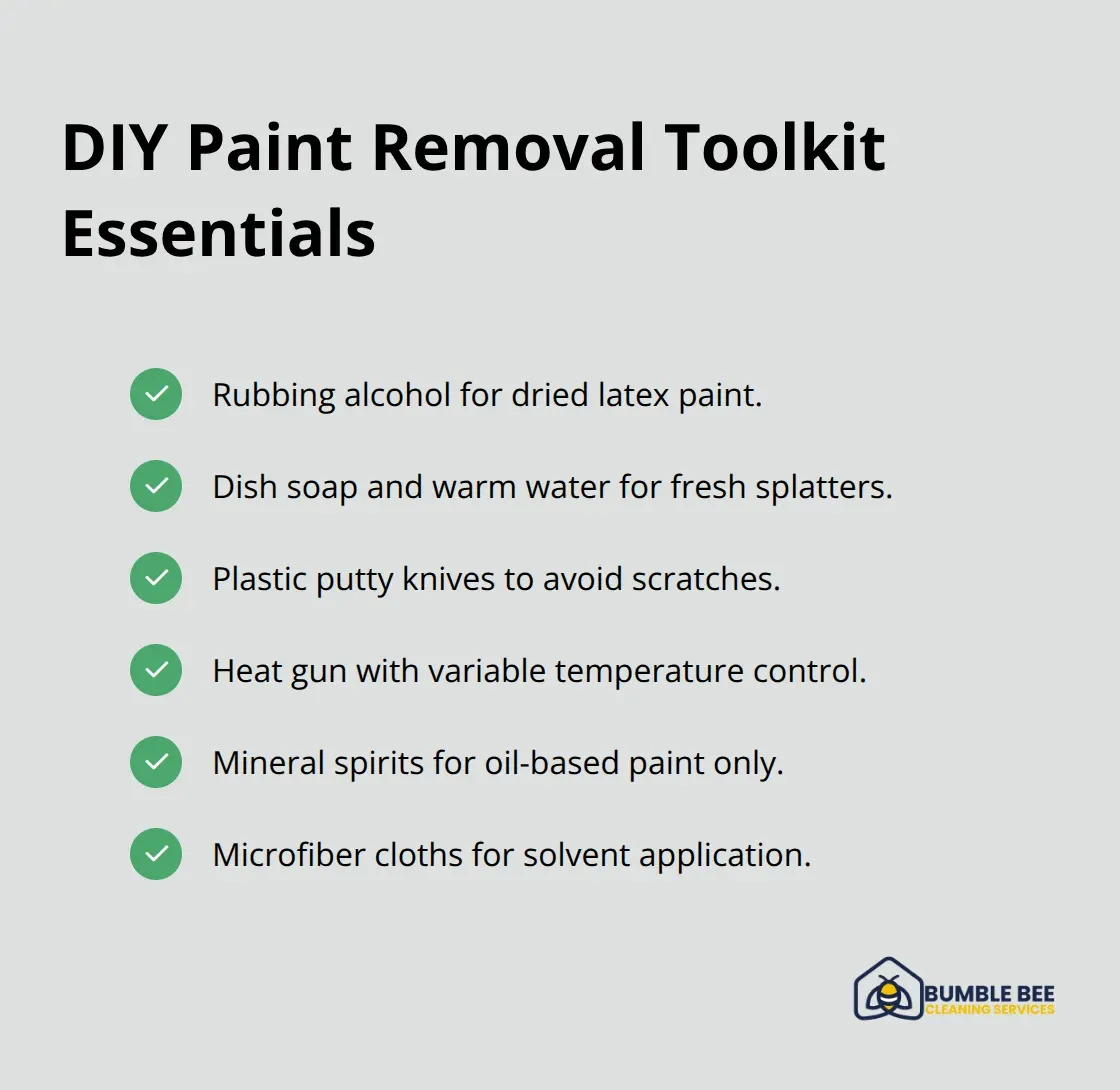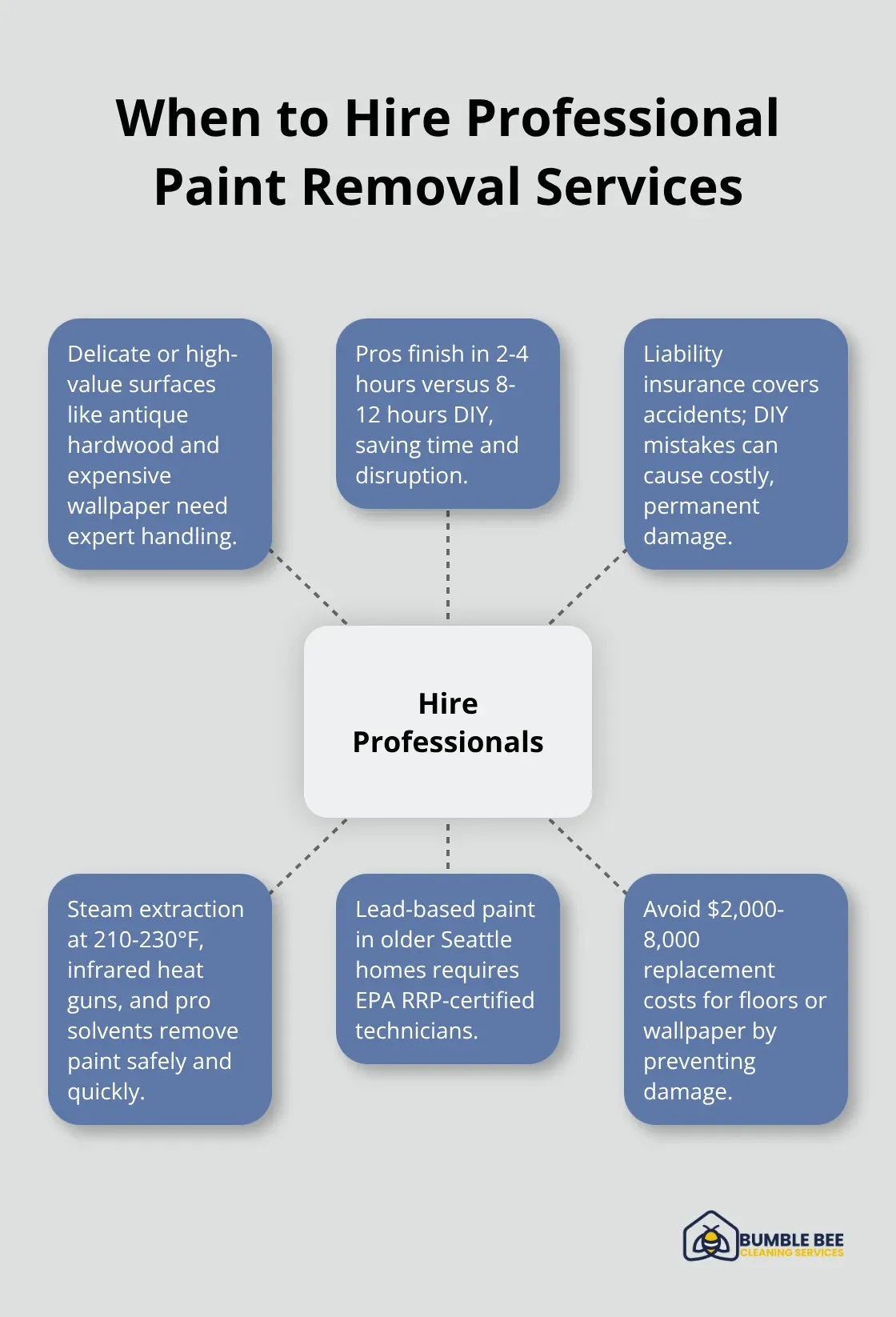Paint splatters happen during even the most careful home improvement projects. Seattle homeowners face unique challenges with our region’s humidity affecting drying times and removal difficulty.
We at Bumble Bee Cleaning Services see paint removal requests weekly from frustrated homeowners. The right technique depends on paint type, surface material, and how long the splatter has been sitting.
Understanding Paint Splatter Types and Surfaces
Water-based paints make up a significant portion of residential interior paints sold today, and 80% of consumers are willing to pay more for eco-friendly paint options. These paints behave completely differently from oil-based paints when spilled. Water-based latex paints stay workable for 30 minutes on most surfaces, which gives you a window to wipe them away with just soap and warm water. Oil-based paints bond within 15 minutes and require mineral spirits or paint thinner for removal. Seattle’s average humidity ranges from 65-78% depending on the season, which extends these work times by roughly 10 minutes, but also makes dried paint more stubborn to remove later.
Water-Based Paint Characteristics
Water-based paints dissolve easily when fresh but create a flexible film once dry. You can identify water-based paint by its mild odor and easy cleanup with soap and water during application. These paints respond well to rubbing alcohol even after they dry (typically within 2-4 hours in Seattle’s climate). The latex polymers in these paints soften when heated, making heat guns effective for older splatters.
Oil-Based Paint Properties
Oil-based paints penetrate deeper into porous surfaces and form harder films than water-based alternatives. These paints emit strong solvent odors and require mineral spirits for cleanup during application. Once cured (usually 6-8 hours), oil-based paint resists water-based removal methods completely. You need chemical solvents or mechanical removal for dried oil-based splatters.
Seattle Surface Challenges
Seattle homes built before 1980 typically feature original hardwood floors, plaster walls, and tile surfaces that react differently to paint removal methods. Hardwood floors expand and contract with our climate, which creates gaps where paint seeps deep. Modern Seattle condos have laminate floors and drywall that handle most removal methods well, except heat guns which can damage laminate backing.
Time Impact on Removal Success
Fresh paint splatters remove with 90% success rates when you use basic soap and water within the first hour. After 24 hours, success rates drop to 40% with the same method. Paint that sits for a week requires mechanical removal or solvents in 85% of cases. Heat guns become necessary for paint older than 30 days, but require temperatures between 200-300°F to avoid surface damage.

Now that you understand what type of paint and surface you’re dealing with, you can choose the right tools and techniques for effective removal.
DIY Paint Splatter Removal Methods
Your paint removal success depends entirely on the right tools for each specific situation. We stock rubbing alcohol, dish soap, plastic putty knives, heat guns, and mineral spirits because each serves a distinct purpose. Rubbing alcohol works on 85% of dried latex paint splatters when you apply it with a microfiber cloth and leave it to sit for 3 minutes before gentle scraping. Heat guns set to 250°F soften paint within 30 seconds but require immediate scraping with plastic tools to avoid surface damage.

Chemical solvents like mineral spirits dissolve oil-based paint in 2-5 minutes but need proper ventilation and should never be used on laminate surfaces.
Essential Tools and Cleaning Supplies
Professional-grade tools make the difference between successful removal and surface damage. Plastic putty knives prevent scratches on delicate surfaces while metal scrapers work best on glass and tile. Microfiber cloths absorb solvents effectively without leaving lint behind. Heat guns with variable temperature controls (ranging from 120°F to 1000°F) give you precise control for different paint types and surfaces. Hand sanitizer with high ethanol content serves as an emergency paint remover when other supplies aren’t available.
Surface-Specific Removal Strategies
Hardwood floors respond best to heat application followed by plastic scraping, while tile surfaces handle chemical solvents without damage. Drywall requires the gentlest approach with soap and water first, then rubbing alcohol if needed, because aggressive methods create permanent texture damage. Laminate floors cannot withstand heat above 180°F or strong solvents, which makes hand sanitizer with ethanol content your safest option for these surfaces. Glass and metal surfaces tolerate any removal method, but mechanical scraping works fastest on these non-porous materials.
Method Selection Based on Paint Age
Fresh paint under 2 hours old removes with warm soapy water and gentle scrubbing 95% of the time. Paint aged 2-24 hours requires rubbing alcohol application for 5 minutes before removal attempts. Splatters older than 24 hours need heat guns for water-based paints or mineral spirits for oil-based varieties. Water-based paints typically complete curing in about 2 weeks and require scraping combined with solvent application, which increases removal time to 15-20 minutes per splatter.
While these DIY methods handle most paint removal situations effectively, some scenarios require professional expertise and commercial-grade equipment to achieve complete removal without surface damage.
When Should You Hire Professional Paint Removal Services
Professional paint removal services become necessary when DIY methods fail or when valuable surfaces require specialized care. Complex paint removal cases challenge homeowners, particularly on antique hardwood floors, expensive wallpaper, or when multiple paint layers create thick buildup. Professional services cost between $150-400 for typical residential jobs, but this investment prevents costly surface replacement that can reach $2,000-8,000 for hardwood floor refinishing or wallpaper replacement in Seattle homes.

Commercial Equipment Advantages
Professional cleaning companies use steam extraction units that operate at 210-230°F with precise pressure control, which removes paint without surface damage. These machines cost $3,000-8,000 and require training to operate safely. Commercial-grade solvents work 3-4 times faster than retail products but need proper ventilation systems and disposal protocols. Heat guns with infrared temperature monitoring prevent overheating, while oscillating multi-tools with carbide blades remove paint from intricate molding details that manual scraping cannot reach effectively.
Time and Risk Considerations
Professional paint removal typically takes 2-4 hours for jobs that would require 8-12 hours of DIY effort. Experienced technicians identify paint composition within minutes and select appropriate removal methods immediately, which eliminates trial-and-error approaches that damage surfaces. Professional liability insurance covers accidental damage during removal, while DIY mistakes with heat guns or chemical solvents can create permanent surface damage (costing thousands in repairs). Seattle’s older homes with lead-based paints require certified professionals with EPA RRP certification for safe removal practices.
Cost Analysis and Value
Professional services charge $75-150 per hour but complete jobs faster than DIY attempts. Surface damage from improper removal techniques costs significantly more than professional fees. Antique hardwood restoration runs $8-12 per square foot when damaged, while professional paint removal prevents this expense entirely. Commercial-grade equipment rental alone costs $200-300 per day (plus deposits), making professional services cost-effective for complex jobs.
Final Thoughts
Paint removal success depends on how you match the right method to your specific situation. Fresh water-based splatters respond to soap and water within the first hour, while dried paint requires rubbing alcohol or heat guns. Oil-based paints always need chemical solvents or professional intervention.
DIY methods work well for simple splatters on durable surfaces like tile or glass. However, valuable hardwood floors, antique surfaces, or multiple paint layers require professional expertise. The cost of professional services (typically $150-400) prevents thousands in surface replacement costs.
After you complete any paint project, protect your surfaces with drop cloths for future work. Clean tools immediately and address splatters within the first hour for easiest removal. We at Bumble Bee Cleaning Services handle complex paint removal situations with commercial-grade equipment and years of experience in Seattle homes.
